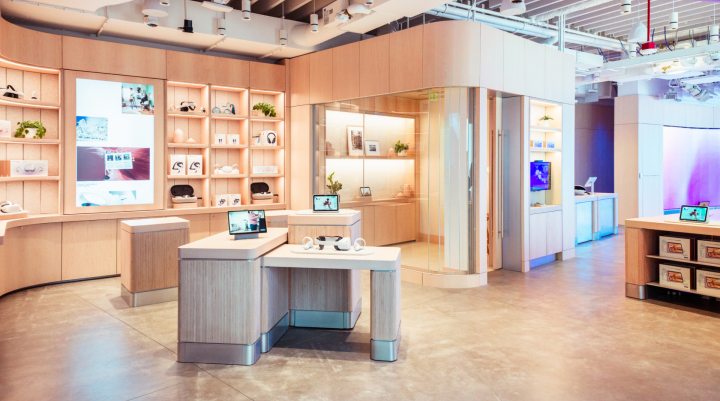Social media behemoth Meta, owner of Facebook and Instagram, has announced it will open its first physical retail store on 9 May at its campus in Burlingame, California. The 144sqm, sleek, minimalist interior space is being designed to showcase immersive technology products. Meta Store aims to encourage people to interact with Meta’s hardware, check out interactive demonstrations, make video calls to retail associates using the Portal smart video calling device, see how the Ray-Ban Stories sun
sunglasses provide hands-free posting to social media, and experience virtual reality in the Quest 2 virtual-headset demo area.
While many people associate Meta with social media, Mark Zuckerberg has a bold outlook that includes building the metaverse and a variety of physical products connected to it.
As such, the Meta Store is opening in close proximity to Reality Labs HQ, Meta’s dedicated research and development facility working on new virtual- and augmented-reality technology. Having the lab and store close together will provide more opportunity to experiment and focus on the customer experience.
“The Meta Store is going to help people make that connection to how our products can be the gateway to the metaverse in the future,” the head of Meta Store, Martin Gilliard, said. “We’re not selling the metaverse in our store, but hopefully people will come in and walk out knowing a little bit more about how our products will help connect them to it.”
In 2021, Meta sold 10 million Quest 2 units and one of its best selling games, Beat Saber, reached over $100 million ($141.5 million) in revenue via the Quest platform. And headset and VR adoption are only a portion of Meta’s vision for the metaverse.
Putting physical technology products in the hands of people allows them to imagine what it will be like to socialise in future virtual environments. Physical retail spaces run by technology companies are less about sales and more about a customer experience that brings mostly everyone along for the journey.
The Apple store effect
When Apple first opened its stores, customers were surprised by the minimal design, open floor plan and attentive, highly capable store associates. It seemed Apple was the first to prioritise design in technology. And it worked, setting a tone for retail and technology going forward.
The Apple store design became a globally recognised aesthetic, which retailers such as Microsoft and Samsung have since replicated. Author Carmine Gallo documented this in great detail in the book, The Apple Experience: Secrets to Building Insanely Great Customer Loyalty.
Putting technology in the hands of the general public is a critical element in the success of those stores. Apple invites customers to learn, attend workshops and demonstrations, ask for help, and get their devices fixed. The stores are retail environments designed for educational purposes and experiences.
This retail strategy is at the heart of Meta Store as well, particularly since Meta’s immersive gadgets are built for socialising in physical and digital environments. Gilliard believes, “Once people experience the technology, they can gain a better appreciation for it. If we did our job right, people should leave and tell their friends, ‘You’ve got to go check out the Meta Store.’ ”
Metaverse or Metaverses?
There are varying opinions on what the metaverse is, who is building it, what people will be able to do in it, and how they will access it. The most common theory is the metaverse won’t be limited to one virtual environment. The metaverse is intended to be open, decentralised, and interoperable. People are building metaverses right now, including Meta, Decentraland, Sandbox, 6529.io, Queendom.io, and Some.place – to name a few. And even more web3 brands are creating non-fungible tokens (NFTs) for use in the metaverse.
Companies such as Meta are manufacturing devices that will enable you to seamlessly move between virtual environments and social spaces, in addition to using a smartphone and computer. These devices provide high-quality, immersive 3D experiences for work, socialising, learning and gaming. They will make cryptocurrency and NFTs necessary assets to trade and use within blockchain-based ecosystems.
But Meta’s retail store also emphasises the importance of physical experiences. There is speculation of the metaverse eventually moving everything online and living entirely in virtual environments but that is not the aim and isn’t realistic.
This new strategy for Meta will be fascinating to watch over time. As the company and its technology evolve, Facebook still remains the most popular social media platform, with an estimated 2.9 billion active users per month recorded in the last quarter of 2021. Meta is likely to be in good position to bring mass users to some version of the metaverse in the very near future. Will you go along for the ride?

